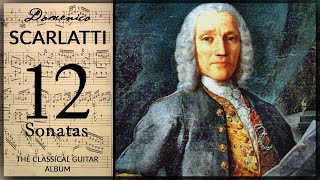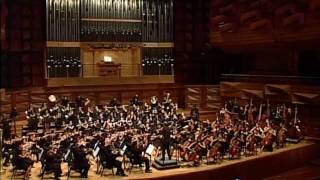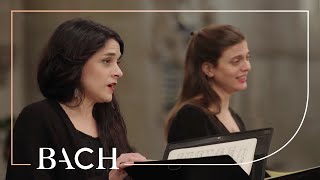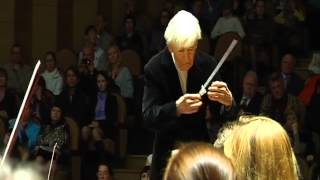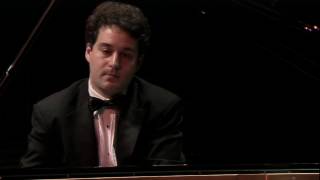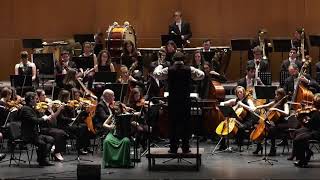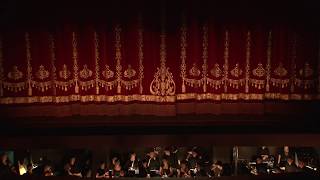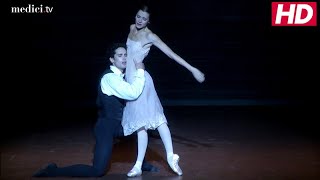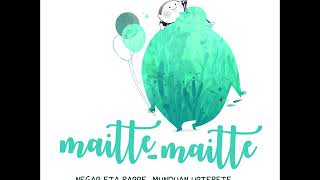Recommended music videos for initiation to classical music
Domenico Scarlatti (1685-1757) - Italian composer who settled in Spain , where he lived almost all his life - is known, above all, for his harpsichord sonatas. He was born in Naples , then belonging to the Spanish Crown , and began his studies with his father, Alessandro Scarlatti . At the age of 16 he was appointed composer and organist at the Royal Chapel of Naples . At 24, he entered the service of the Polish queen Maria Casimira who was exiled in Rome , where he was chapel master of St. Peter's Basilica . In 1729 he moved to Seville where he lived until 1733, the year in which he would move his permanent residence to Madrid where he composed around 500 sonatas, for which he went down in history. He died in Madrid at the age of 71.
D. Scarlatti's sonatas have a binary structure, composed of a first part as an exposition and a second part that repeats, with some variations, the melodic and rhythmic elements that had already appeared in the first part. Each part is repeated and ends with similar cadences, the first often in the dominant and the second in the tonic. This is a typical structure of the sonatas of the period, which we find in other keyboard sonatas by contemporary composers of Scarlatti , such as Antonio Soler .
The musical motifs are very rich and varied in each sonata, which is why it has been said that the composer explores all the capabilities of the instrument's keyboard, an exploration that in some sonatas leads to execution difficulties for the performer, with octave or major jumps, complicated arpeggios, very fast scales or hand crossings.
Today we offer a collection of 12 sonatas, in guitar version, performed by different top-level guitarists.
Alexander Borodin (1833-1887) was a Russian doctor, chemist and composer, a member of the Five and a staunch defender of women's rights , a promoter of education in Russia and the founder of a medical school for women. The illegitimate son of the Russian prince Luka Stepánovitch Gedevanishvili, he had a comfortable and well-educated youth; he studied piano, cello and flute on his own and at the age of 15 he enrolled in the Faculty of Medicine, specialising in Chemistry , a profession he would practice for life. At the age of 30 he began to study composition with Balakirev and as an amateur he wrote chamber music and some religious works, three symphonies, the poem On the Steppes of Central Asia and the opera Prince Igor.
A string trio is a group of three string instruments or a piece written for such an ensemble, usually a violin, viola and cello. The earliest string trio compositional formation consisted of two violins and a cello, an ensemble that evolved from the Baroque trio sonata . The term can also refer to instrumental works from the Classical period to the present, which usually have as instruments a violin, viola and cello. Before the current version, the Renaissance Consort pieces (a popular instrumental ensemble in England during the 16th and 17th centuries) and the Baroque Sonata were written for trio, either for violas or violins, with or without basso continuo.
Today we offer Alexander Borodin 's String Trio in G minor performed by violinists Imala Witherspoon and Katia Tesarczyk with cellist Madeline Sheard
Camille Saint-Saëns (1835-1921) was a French pianist, organist, composer and military man, committed to the French musical renewal, as well as to teaching; students such as Fauré and Messager passed through his classrooms. He was a precocious child who at the age of 11 made his first public appearance with works by Handel , Mozart and Beethoven . At the age of thirteen he enrolled in organ and composition at the Paris Conservatory and at eighteen, he composed his first symphony. He was a multifaceted intellectual: musician, writer, mathematician, philosopher, archaeologist, geologist, botanist ... Equally multifaceted were his numerous musical works (more than 400) in which he tackled all kinds of genres among which it is worth highlighting the novelty that film music represented at that time.
Catalogue of the works of Saint–Saëns . His works are classified by their Opus number (from the Latin opus 'work') which is a term used in music to catalogue the works of most composers. Since the 17th century , this form of cataloging began to be used every time a work was published, preceding the order number of the work with the word Opus , or its abbreviation Op .. Despite the above, there are many of our composer's works that are not properly classified.
Samson et Dalila, Op. 47 is a grand opera in three acts with music by Camille Saint-Saëns and a French libretto by Ferdinand Lemaire . It premiered in Weimar , Germany on 2 December 1877, in a German version, at the Grossherzogliches ("Grand Duke's") Theater , today the Staatskapelle Weimar. The opera is based on the biblical tale of Samson and Delilah found in chapter 16 of the Book of Judges in the Old Testament and tells the story of Israel 's most famous judge, consecrated from his mother's womb to be the leader of the chosen people, endowed with superhuman spiritual and physical strength, capable of destroying the Philistine army with the sole power of his arm. Strength had a condition, a "divine reminder" that Samson was still a man, and therefore vulnerable to sin and weakness: his strength lay in his long hair and if something happened to it, he would lose it, as happened after being seduced by the Philistine Delilah , who cut his hair while he slept.
The Bacchanale is a dance from Act III of Samson et Dalila , which shows the moral baseness of the infidels after having annulled Samson 's strength. Today, in concert version, it is offered to us by the Caracas Youth Symphony Orchestra conducted by the Venezuelan maestro Dietrich Paredes .
Gerónimo Giménez (1854 –1923) was a Spanish composer and conductor, who devoted himself mainly to the composition of zarzuelas, leaving behind notable titles such as La tempranica or La boda de Luis Alonso . He began his musical studies with his father and later continued in Cádiz with Salvador Viniegra . He was a child prodigy, who at the age of 12 became first violinist at the Teatro Principal in Cádiz . At the age of 17 he was already director of an opera and zarzuela company and received a scholarship to study violin and composition in Paris . In 1885 he was appointed director of the Teatro Apolo in Madrid ; shortly afterwards, director of the Teatro de la Zarzuela and later, director of the Sociedad de Conciertos , a position he held for 12 years. He died in Madrid on 19 February 1923.
Manuel Nieto y Matany (1844 - 1915) was a Catalan composer and conductor, the son of a military musician stationed in Reus . He learned music from his father and also in the Reus Music Band, which he joined at the age of nine. He lived in Córdoba , where in 1860 he premiered the zarzuela " La Toma de Tetuán ", written without an ending, because the African War had not yet ended, in Badajoz (1861, where he was a piano teacher) and in Valladolid before moving to Madrid permanently in 1869. He initially dedicated himself to directing the choirs of the Teatro Real and the Teatro Rossini , and also conducted the orchestras of other Madrid theatres. He worked on composition, and wrote works for piano and romances; but the genre that he cultivated the most was the zarzuela , with more than two hundred works written, sometimes in collaboration with other musicians such as Joaquin Candela, Fernandez Caballero, Ruperto Chapi, Gerónimo Gimenez, Tomas Breton, Pedro Miquel Marques .
The Barber of Seville is a zarzuela, in one act, divided into three scenes, with a libretto by Guillermo Perrín y Vico and Miguel de Palacios, with music by Gerónimo Giménez and Manuel Nieto . It premiered at the Teatro de la Zarzuela in Madrid on February 5, 1901. Within the spectrum of the genre chico, it is worth highlighting the field of theater within theater , exploited at length and with such clear examples as The duo of La africana, or The genre ínfimo and always offering a caricaturesque and parodic vision, with very happy results. In our case, the librettists use a well-known resource (that of an aspiring singer, who finds opposition from a relative), to create highly comic situations and offer a very well-achieved stage approach. In the musical section, it is worth highlighting the collaboration of two great musicians, Miguel Nieto and Gerónimo Giménez , creating a fresh and highly elaborate score, with bits of opera and vocal treatment, being famous, above all, the famous polonaise that we offer today: Me llame la primorosa .
Today's performance is by Egyptian soprano Fatma Said accompanied by the Junge Symphonie Berlin conducted by Lithuanian maestro Giedre Šlekyte .
Recommended classical music videos
Johann Sebastian Bach (1685-1750) was a German violinist, organist, conductor and composer, born in Eisenach into the most prominent musical family in history. In 1703 he obtained his first job in Arndstat and in 1707 he moved to Mülhausen as an organist, where he married his cousin Maria Barbara with whom he had seven children. After the death of his wife in 1720, he married again to Maria Magdalena with whom he would have another thirteen children. In 1723 he moved to Leipzig where he would reside until his death at the age of 65. Considered one of the three main geniuses in the history of music along with Mozart and Beethoven, his influence has been notable on Haydn , Mozart , Beethoven , Mendelssohn , Schumann , Chopin ... and many other renowned composers.
The Mass in B minor, BWV 232 is a sacred piece for soloists, chorus and orchestra, written by Johann Sebastian Bach . The Mass is a compendium of many different styles in vocal composition, both in the Stile Antico reminiscent of Renaissance music (containing even Gregorian chant) and in the Baroque concertante style of its time: writing and dances with fugues, arias and a movement for two four-voice choirs. Similar to the architecture of the period, Bach achieved a symmetry of the parts, with the profession of faith ( Credo ) at the center of the Mass and the Crucifixus at the center of the Credo .
Extract from the video caption : Sublime, extreme and all-encompassing – only superlatives can describe Bach ’s Mass in B minor . Between a stunning Kyrie and the jubilant final Dona nobis pacem , there are nine completely unique arias and duets, fourteen stunning ensemble sections for four, five, six and even eight voices, a wide spectrum of instrumental solos and an incredible variety of styles.
STRUCTURE . 0:00 Kyrie eleison (Chorus) .-. 11:07 Christe eleison (Duetto) .-. 15:56 Kyrie eleison (Chorus) .-. 19:43 Gloria in excelsis Deo (Chorus).-. 21:25 Et in terra pax (Chorus).-. 26:06 Laudamus te (Aria) .-. 30:09 Gratias agimus tibi (Chorus) .-. 33:19 Domine Deus (Duetto) .-. 38:39 Qui tollis (Chorus).-. 41:39 Who are you (Aria) .-. 45:50 Quoniam tu solus sanctus (Aria).-. 50:33 Cum Sancto Spiritu (Chorus) .-. 54:14 Credo in unum Deum (Chorus).-. 56:13 Patrem omnipotentem (Chorus).-. 58:15 Et in unum Dominum (Duetto).-. 1:02:38 Et incarnatus est (Chorus).-. 1:05:52 Crucifixus (Chorus) .-. 1:08:58 Et resurrexit (Chorus).-. 1:12:56 Et in Spiritum Sanctum (Aria).-. 1:18:13 Confiteor (Chorus) .-. 1:22:18 Et exspecto (Chorus).-. 1:24:30 Sanctus (Chorus) .-. 1:26:58 Pleni sunt coeli (Concertante).-. 1:29:19 Hosanna in excelsis (Chorus).-. 1:31:59 Benedictus qui venit (Aria).-. 1:36:22 Hosanna in excelsis (Chorus).-. 1:39:05 Agnus Dei (Aria) .-. 1:45:17 Dona nobis pacem (Chorus)
The interpretation is offered by sopranos Hana Blažíková and Anna Reinhold , alto David Erler , tenor Thomas Hobbs and bass Peter Harvey accompanied by the Dutch Bach Society and conducted by the also Dutch maestro Jos van Veldhoven .
Luigi Cherubini (1760-1842) was an Italian composer. His instruction in music began at the age of six with his father, a harpsichordist, at the Teatro della Pergola in Florence , and subsequently with A. Felici . By the age of thirteen he had already written some religious works. In 1778 he studied music in Bologna and from 1778 to 1782 he continued his studies in Milan under Giuseppe Sarti . In 1779 he premiered in Alessandria his first melodrama, Quinto Fabio , and during the following years he composed for the theatres of Tuscany, Rome, Venice and Mantua . In 1787 he settled in Paris , where he composed several operas. In 1805 Cherubini received an invitation from Vienna to write and conduct an opera, Fanista , which was enthusiastically received, particularly by Haydn and Beethoven . In 1816 he was appointed Superintendent of the King's Music and Director of the Conservatory in 1822. Throughout his life he composed abundant lyrical and religious works, as well as various chamber and symphonic works. He died in Paris at the age of 81 and was buried in the Père Lachaise Cemetery.
Symphony . The word symphony derives from the Latin symphonĭa, which in turn comes from the Greek συμφωνία (symphōnía), meaning "consonance" as opposed to διαφωνία (diaphōnia), meaning "dissonance." In the Middle Ages and later, the word symphony was used to describe various instruments, especially those capable of producing more than one sound simultaneously in the sense of "sounding together." The word began to appear in the titles of some works by 16th- and 17th- century composers; by the late 18th century the word had acquired the common meaning assigned to it today: a work usually consisting of several distinct sections or movements and most often composed for orchestra.
Today we offer Cherubini 's Symphony in D major structured in four movements: I (00´00´´) LARGO – (1´42´´) ALLEGRO .-. II (10´06) LARGHETTO CANTABILE .-. III (17´26´´) MINUETTO .-. IV (22´05´´) ALLEGRO ASSAI conducted by the Italian maestro Piero Bellugi (1924-2012).
Maurice Ravel (1875-1937), born in Ziburu/Ciboure (Basque Country in France), inherited his father, an engineer of Swiss origin, his meticulousness in work, and his mother, born in Mendata (Bizkaia), his passion for music with the folk songs with which he adorned his childhood. A few months after his birth, the family moved to Paris , where at the age of six he began his piano studies. At the age of 14 he entered the Paris Conservatoire where he had the opportunity to study with Gabriel Fauré . In 1901 he premiered his Jeux d´eau , a piano work with which he began to make his way in the musical circles of Paris where there was discussion about the influence of Ravel on Debussy and vice versa. In 1921 he settled in a mansion near Paris until his death, where eminent musicians and intellectuals met.
Miroirs (Mirrors) is a five-piece piano suite composed by Maurice Ravel between 1904 and 1905. It was premiered by the Spanish pianist Ricardo Viñes on 6 January 1906 at the Salle Érard. Each of the pieces is dedicated to one of his friends, five members of the avant-garde artistic group, Les Apaches . In the same year, it was published by Eugène Demets .
Structure: I (0´05´´) NOCTUELLES ("Moths"). Dedicated to Léon-Paul Fargue , Noctuelles is a highly expressive piece that begins with a chromatic series, maintaining a dark, nocturnal mood evoking the flight of moths, nocturnal animals. The middle section is calmer with rich melodies and chords. -. II (4´34´´) OISEAUX TRISTES ("Sad Birds"). Dedicated to Ricardo Viñes , the shortest, evokes a solitary bird whistling a sad melody, after which others join in participating in a true polyphony of birds. The middle section, very harmonically coloured, is more exuberant and continues with a solemn cadence that brings back the melancholic mood of the beginning, as if all these birds were singing, each to its own solitude. Ravel considered this piece to be his most important and claimed that he wanted to evoke "birds lost in a dark forest during the hottest hours of summer".-. III (8´06´´) UNE BARQUE SUR L'OCÉAN ("A boat on the ocean"). Dedicated to Paul Sordes , it evokes a boat sailing on the waves of the ocean. The arpeggiated sections and melodies imitate the flow of ocean currents. It is the longest piece and the second most difficult to perform.-. IV (15´01´´) ALBORADA DEL GRACIOSO. Dedicated to Michel-Dimitri Calvocoressi , this alborada is a technically difficult piece to perform that integrates popular Spanish dances into complex melodies and is reminiscent of guitars. It contains impressionistic melodies and passages of considerable virtuosity, with the repeated notes being considered one of the most difficult passages in piano music.-. V (21´40´´) LA VALLÉE DES CLOCHES ("The Valley of the Bells"). Dedicated to Maurice Delage , Ravel 's first pupil. The inspiration for the piece, in a poetic atmosphere, is found in the sound of church bells, bathed in a dreamlike climate that is both mystical and voluptuous, from the delicate bells of the opening to the ascending bells of the closing, through a subtle use of sonorous harmonies. Some of Ravel 's most surprising melodies occur in this piece, often with exuberant harmonizations.
Today's performance is by Oxana Shevchenko (1987 Almaty, Kazakhstan), internationally recognized as a pianist of extraordinary talent, sensitivity and versatility.
Gorka Hermosa Sánchez (Villarreal de Urrechua, Guipúzcoa, 1976) is a Basque composer, accordionist, teacher and writer. He began studying music in Zumárraga with Javier Ramos ; after him, he trained with the Frenchman Thierry Paillet and after two years, he had the opportunity to study with the professor of the Moscow Conservatory, Friedrich Lips , finishing his higher studies in accordion at the Conservatory of Vitoria/Gasteiz with an honorary award. In 1998 he won the Permanent Competition for Young Performers of Juventudes Musicales de España . In 2004 he published his book El repertorio para acordeón en el estado español . Since 2005 he has been in charge of the accordion classes at the Jesús de Monasterio Conservatory in Santander .
Her first solo album was recorded in 2006 under the title Tangosophy , where she combined traditional Iberian rhythms such as bulería, fandango or jota. In 2014 she recorded her second solo album, Heterodoxia , as a celebration of her 25 years in music. The work mixes classical music with jazz, flamenco and tango . In 2020 she published her third solo album, Fragilissimo , a work that mixes styles such as impressionism, contemporary, minimalist, neotonal and popular works . In 2022 she presented the album Flamenco Etxea together with flamenco guitarist José Luis Montón . At the end of the following year she also presented the album Sustraien matxinada together with Garikoitz Mendizabal (txistu).
In 2014, 2016 and 2017 he won the International Composition Contest of the Confédération Mondiale de l'Accordéon. In 2017 the Polish Lukas Gogol won the television show Got Talent with two works by Hermosa . In 2019 Gorka Hermosa appeared among the ten most beloved accordionists in the world for the American magazine Accordion Stars . In 2020 he was named one of the six tourism ambassadors of Gipuzkoa by the Provincial Council; the following year he played with the String Quartet in Siberia , as well as performing solo concerts in Normandy and Ostrava . In 2022 the Confédération Mondiale de l'Accordéon (CMA) organized the Gorka Hermosa International Composition Contest in Tianjin . His works have been performed by more than 40 orchestras in Europe, the United States, Brazil and South Korea , such as the Berliner Symphonike r.
Today we offer his Concerto for accordion and orchestra with Marta Cubas Holdal as soloist, accompanied by the Youth Symphony Orchestra “Ciudad de Salamanca” conducted by the Madrid maestro Álvaro Lozano .
Recommended music videos for all tastes
Nina Simone (1933–2003) was an American jazz, blues, rhythm and blues, and soul singer, songwriter, and pianist. She is known by the nickname "High Priestess of Soul ." Her contralto voice was characterized by passion, breathlessness, and tremolo. The influence of Duke Ellington is evident in all of Nina 's work, but especially in certain types of compositions full of improvisation and spiritual closeness. A great fighter for the civil rights of people of African descent, she left the United States in 1969, after the assassination of Martin Luther King , fed up with racial segregation against African Americans. She received 15 Grammy Award nominations and was inducted into the Grammy Hall of Fame in 2000.
Claudia Leitte (1980) is a Brazilian singer who was part of a children's band at the age of seven and was already performing professionally at the age of thirteen. She sang in nightclubs and at carnivals; she was in several groups until she participated in the formation of the new group, with the help of the company " Bicho da Cara-Preta ", specialized in successful and popular groups such as " É o Tchan ". From 2001 to 2008 she was the vocalist of Babado Novo , although in December 2005 she performed in the Christmas special of the singer Roberto Carlos . In 2008 she recorded her first single and her live performance was attended by more than 700,000 people on Copacabana beach. Despite her young age, she has toured Brazil nine times and is currently one of its most famous singers.
Justin Bieber (born 1994) is a Canadian singer-songwriter and global superstar. In 2008, former music industry executive Scooter Braun accidentally discovered Justin Bieber 's talent while watching some YouTube videos, where Bieber was uploading covers of his favorite singers that he performed with his guitar. Bieber has been nominated and awarded numerous times, winning the American Music Awards ' "Artist Of The Year" award in 2010 and being nominated at the 53rd Grammy Awards in the categories of Best New Artist and Best Pop Album. Bieber is the only singer to have 12 songs on the highest charts in the history of the music industry, thus surpassing Michael Jackson ; and in 2011, he dethroned Elvis Presley 's position of achieving 7 #1 hits before the age of 25.
Denise Barbacena (born November 2, 1994 in Manila) is a Filipino hip hop and rap singer and actress who participated in the reality show Protégé , broadcast on the GMA Network . Her coach was rapper Gloc-9 , although she was eliminated from the contest on November 6, 2011, finishing in 8th place. Denise has continued to move forward with her artistic career. She collaborated with Gloc-9 on two of his songs, "Hari ng Tondo" and "Dapat Tama" , which were quite successful.
Recommended peculiar videos
Adolphe Adam (1803-1856) was a French composer born in Paris and author of abundant scenic music. His first successes came in his adult years with the ballet Giselle and the opera Si j'étais roi ; by then he had already written several ballets and operas; in total he wrote 40 operas, 14 ballets and various cantatas, hymns, masses, choruses, piano pieces, pantomimes, military marches and plays; of all these compositions it is worth highlighting, in addition to those already mentioned, the Christmas carol Cantique de Noël , world-famous in its English translation as O Holy Night. and the ballet Le Corsaire , which we are offering today. From 1849 until his death in 1856 he was professor of composition at the Paris Conservatory .
Le Corsaire (The Corsair) is a ballet in three acts, five tableaux and an epilogue to a libretto by Jules- Henri Vernoy de Saint-Georges , inspired by Lord Byron's poem The Corsair and its derivative opera Le Corsaire by Verdi , with music by Adolphe Adam . The original choreography was by Joseph Mazilier and it was first performed at the Paris Opera in 1856 . In 1868, Marius Petipa and Jules Perrot gave a revival of the ballet for the Bolshoi Theatre in Moscow . This version is the one from which most later adaptations and productions, such as the current one by the Samara Theatre ballet company, are derived.
Frédéric Chopin (1810-1849) was a Polish virtuoso pianist and composer, who was born into a musical family; his mother played the piano and his father, the violin and the flute; his first teacher was a sister with whom he liked to play four-handed pieces. At the age of eight he gave his first public concert at the Radziwill family palace in Warsaw . Chopin 's work focuses exclusively on the piano, solo or concertante, with which he embarked on a solo career of technical perfection, expressive splendor and deepening in rubato until he became the musical reference for said instrument. As a pianist, he is considered one of the most important in history and as a composer, one of the references of Romanticism .
La Dame aux Camélias is a ballet premiered in 1978 created by the German choreographer John Neumeier , with music by Frederic Chopin . The work is based on the novel by Alexandre Dumas (son) “La Dame aux Camélias”. The son of the great novelist, Alexandre Dumas , had to live in the shadow of the success of his father, whose name he shared. When at the age of 23 he published “ The Lady of the Camellias ” it was believed that such a brilliant work had to be by his father. This novel is based on the life of a famous Parisian courtesan named Marguerite Gautier . Social conventions are at the heart of this masterpiece, which Dumas himself later brought to the stage and which was the basis for Verdi 's opera “ La Traviata ”.
Today we will attend the Pas de deux from the third act, performed by Agnès Letestu and Stéphane Bullion (both stars of the Paris National Opera)
Joaquín Turina (1882-1949) was a pianist, composer and conductor born in Seville and author of the most important works of Spanish Impressionism together with Falla and Albéniz . Since childhood, considered a "prodigy", he improvised virtuosically on the accordion; although he began his piano studies at the same time as high school. In 1903 his parents died and he moved to Paris where he studied composition with Vincent D'Indy earning his living with his piano performances. In 1913 when the First World War broke out, he returned to Madrid where he permanently took up residence. He was named a full member of the Royal Academy of Fine Arts of San Fernando , a favorite son of Seville, in addition to receiving other important awards such as the Grand Cross of Alfonso X the Wise .
Danzas fantásticas , Op. 22, is Joaquín Turina ’s best-known work; inspired by José Mas ’s novel La orgía , it was written between 11 and 29 August 1919, originally for piano and later transcribed for orchestra. The work consists of three dances: Exaltation, Dream and Orgy . The third, Orgy , which is the one we are offering today, is an Andalusian farruca headed by a quote from Mas ’s novel: “The perfume of the flowers was confused with the smell of chamomile, and from the bottom of the narrow glasses, filled with incomparable wine, like incense, joy rose.” Today we are offering it in a version by the Ballet Alhambra dance corps.
Tibetan dance . The unique way of life of the Tibetan people is deeply reflected in their dance. Perhaps the most defining feature of their style is the forward bending of the body, accompanied by a ceaseless bouncing of the knees. This rhythm accompanies almost all movements and originates from the everyday custom of carrying water long distances from mountain rivers to their homes.
Tibetan dance also has the peculiarity of simultaneously extending the arm and leg on the same side, instead of the alternating way of walking. This also has its origins in the treacherous climbs of the Himalayas ; in order to traverse the steep mountain paths more efficiently, Tibetans put their weight on one side of their body, which allows them to save energy on their daily walks.
Tibetan dances – especially those performed by men – are also known for their energetic use of techniques. These include vigorous jumps and spins, danced in the distinctive high-heeled boots. (Excerpted from Shen Yun Performing Arts)
Recommended music videos for children
Various Wikipedia articles have been used to write these texts.
The texts of Videomusicalis are written in Basque, Spanish and English.





